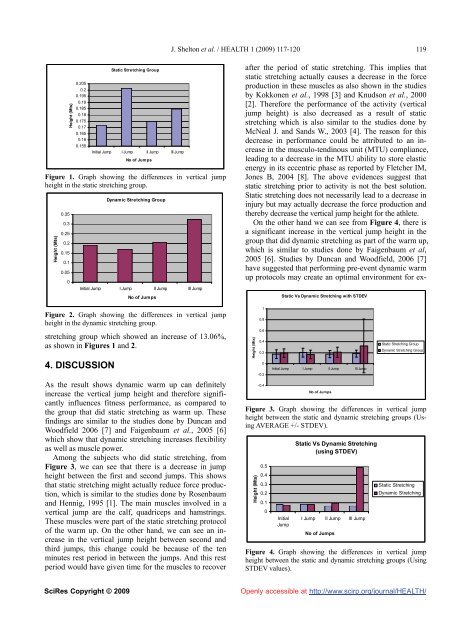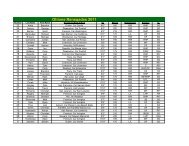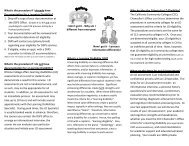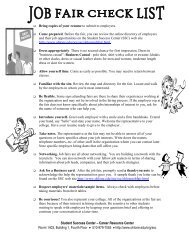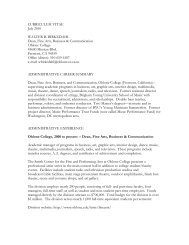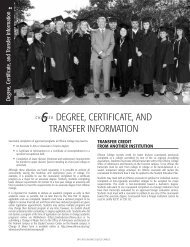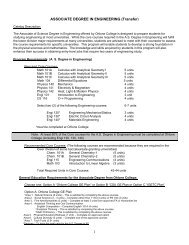2012 Athletic Guide Preparation for Soccer - Men's ... - Ohlone College
2012 Athletic Guide Preparation for Soccer - Men's ... - Ohlone College
2012 Athletic Guide Preparation for Soccer - Men's ... - Ohlone College
You also want an ePaper? Increase the reach of your titles
YUMPU automatically turns print PDFs into web optimized ePapers that Google loves.
J. Shelton et al. / HEALTH 1 (2009) 117-120 119<br />
Height (Mts)<br />
0.205<br />
0.2<br />
0.195<br />
0.19<br />
0.185<br />
0.18<br />
0.175<br />
0.17<br />
0.165<br />
0.16<br />
0.155<br />
Static Stretching Group<br />
Initial Jump I Jump II Jump III Jump<br />
No of Jum ps<br />
Figure 1. Graph showing the differences in vertical jump<br />
height in the static stretching group.<br />
Height (Mts)<br />
0.35<br />
0.3<br />
0.25<br />
0.2<br />
0.15<br />
0.1<br />
0.05<br />
0<br />
Dynamic Stretching Group<br />
Initial Jump I Jump II Jump III Jump<br />
No of Jumps<br />
Figure 2. Graph showing the differences in vertical jump<br />
height in the dynamic stretching group.<br />
stretching group which showed an increase of 13.06%,<br />
as shown in Figures 1 and 2.<br />
4. DISCUSSION<br />
As the result shows dynamic warm up can definitely<br />
increase the vertical jump height and there<strong>for</strong>e significantly<br />
influences fitness per<strong>for</strong>mance, as compared to<br />
the group that did static stretching as warm up. These<br />
findings are similar to the studies done by Duncan and<br />
Woodfield 2006 [7] and Faigenbaum et al., 2005 [6]<br />
which show that dynamic stretching increases flexibility<br />
as well as muscle power.<br />
Among the subjects who did static stretching, from<br />
Figure 3, we can see that there is a decrease in jump<br />
height between the first and second jumps. This shows<br />
that static stretching might actually reduce <strong>for</strong>ce production,<br />
which is similar to the studies done by Rosenbaum<br />
and Hennig, 1995 [1]. The main muscles involved in a<br />
vertical jump are the calf, quadriceps and hamstrings.<br />
These muscles were part of the static stretching protocol<br />
of the warm up. On the other hand, we can see an increase<br />
in the vertical jump height between second and<br />
third jumps, this change could be because of the ten<br />
minutes rest period in between the jumps. And this rest<br />
period would have given time <strong>for</strong> the muscles to recover<br />
after the period of static stretching. This implies that<br />
static stretching actually causes a decrease in the <strong>for</strong>ce<br />
production in these muscles as also shown in the studies<br />
by Kokkonen et al., 1998 [3] and Knudson et al., 2000<br />
[2]. There<strong>for</strong>e the per<strong>for</strong>mance of the activity (vertical<br />
jump height) is also decreased as a result of static<br />
stretching which is also similar to the studies done by<br />
McNeal J. and Sands W., 2003 [4]. The reason <strong>for</strong> this<br />
decrease in per<strong>for</strong>mance could be attributed to an increase<br />
in the musculo-tendinous unit (MTU) compliance,<br />
leading to a decrease in the MTU ability to store elastic<br />
energy in its eccentric phase as reported by Fletcher IM,<br />
Jones B, 2004 [8]. The above evidences suggest that<br />
static stretching prior to activity is not the best solution.<br />
Static stretching does not necessarily lead to a decrease in<br />
injury but may actually decrease the <strong>for</strong>ce production and<br />
thereby decrease the vertical jump height <strong>for</strong> the athlete.<br />
On the other hand we can see from Figure 4, there is<br />
a significant increase in the vertical jump height in the<br />
group that did dynamic stretching as part of the warm up,<br />
which is similar to studies done by Faigenbaum et al,<br />
2005 [6]. Studies by Duncan and Woodfield, 2006 [7]<br />
have suggested that per<strong>for</strong>ming pre-event dynamic warm<br />
up protocols may create an optimal environment <strong>for</strong> ex-<br />
Height (Mts)<br />
1<br />
0.8<br />
0.6<br />
0.4<br />
0.2<br />
0<br />
-0.2<br />
-0.4<br />
Static Vs Dynamic Stretching with STDEV<br />
Initial Jump I Jump II Jump III Jump<br />
No of Jum ps<br />
Static Stretching Group<br />
Dynamic Stretching Group<br />
Figure 3. Graph showing the differences in vertical jump<br />
height between the static and dynamic stretching groups (Using<br />
AVERAGE +/- STDEV).<br />
Height (Mts)<br />
0.5<br />
0.4<br />
0.3<br />
0.2<br />
0.1<br />
0<br />
Initial<br />
Jump<br />
Static Vs Dynamic Stretching<br />
(using STDEV)<br />
I Jump II Jump III Jump<br />
No of Jumps<br />
Static Stretching<br />
Dynamic Stretching<br />
Figure 4. Graph showing the differences in vertical jump<br />
height between the static and dynamic stretching groups (Using<br />
STDEV values).<br />
SciRes Copyright © 2009<br />
Openly accessible at http://www.scirp.org/journal/HEALTH/


